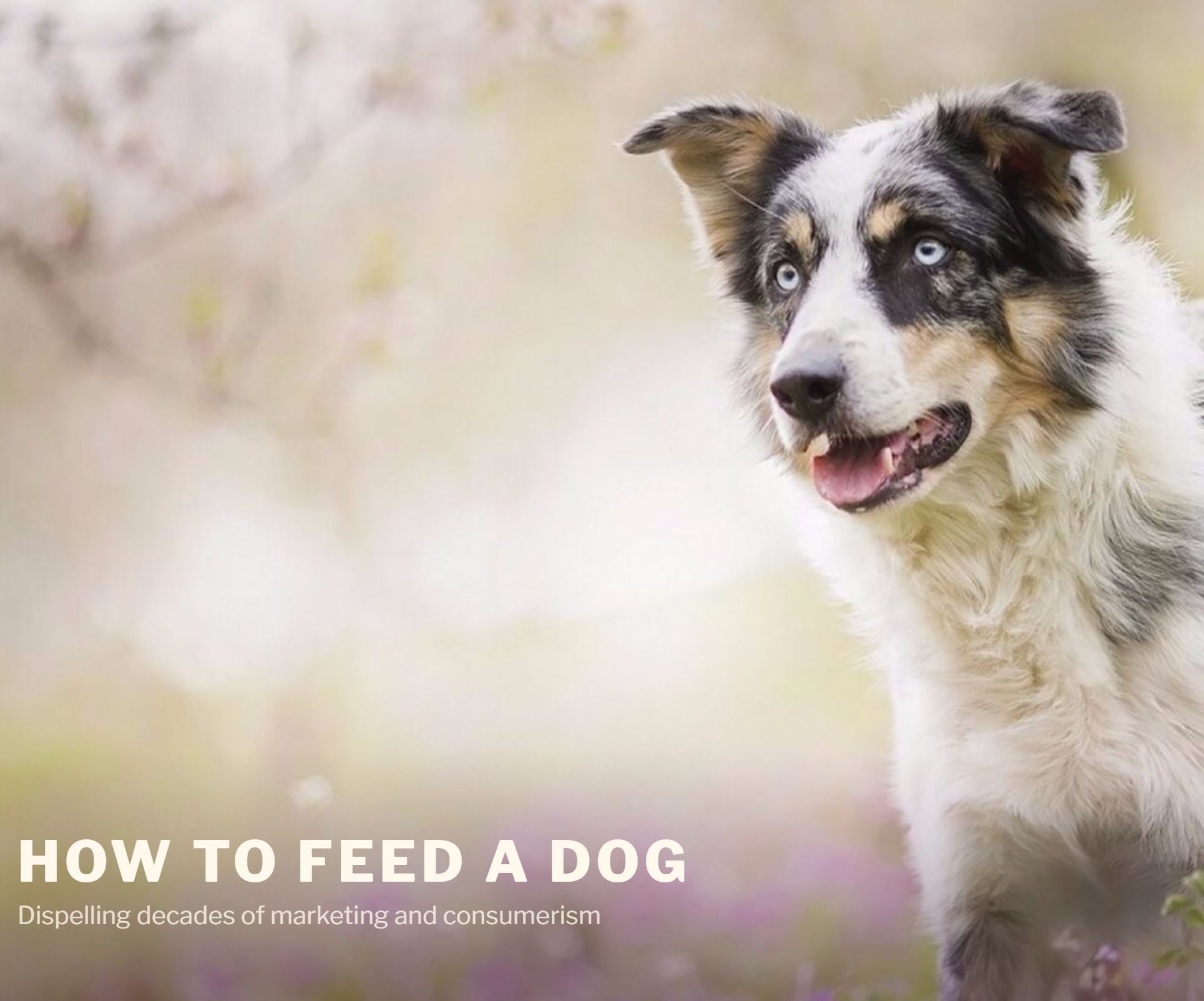
Hi, and welcome to my guide on How to Feed a Dog – a simple no nonsense introduction on feeding our furry housemates, be it puppies, dogs, kittens, or cats.
As a qualified pet nutritionist and advocate for real pet health I’ve studied and reviewed pet food for many years (over a decade), dealt with consumers, retailers, manufacturers, and universities alike. I’ve learned many things and helped many dogs along the way. Unfortunately I’ve found a strong discord between what we’re taught and told, and what really works for our pets.
I’m not an evangelist, I’m a pragmatist. I advocate the feeding of a prey diet but understand the practicalities of feeding dry food, wet food, or other commercial products.
I recommend variety, and I recommend you avoid feeding your pet the same product day after day.
So sit back, have a cup of tea, and enjoy this 15 minute insight into how I think you should feed a dog (or cat).
The pet food industry problem – products & profit
The sheer profiteering in the pet food industry is staggering, and it grossly neglects the one truly important thing – the health of our pets.
We’ve all been deceived by clever marketing and corporate influence, and so have our vets (they’re pet doctors, not pet nutritionists). When I studied to be a qualified pet nutritionist I was very aware how many products were recommended, including Mars’ brand Greenies for dental health, and Hill’s Science Diet dry food for optimum nutrition.
Did you know Mars have their own university for training vets about nutrition? You have to ask yourself – is it a conflict of interest when a pet food manufacturer trains the professionals who inform pet owners what products to feed their pets?
Many vets worldwide endorse products without every considering what they’re made from, or questioning why. For example, if your cat has kidney failure (like many older cats these days) then they may recommend a brand like Hill’s Science Diet k/d, made from grains, without moisture, which is far from being an appropriate kidney diet.
Because of factors such as the above, most cats are fed a completely inappropriate diet of grains despite being obligate carnivores, and the situation isn’t much better for dogs either.
Mars Petcare University, as well as other organisations in the pet food industry, would like us to believe dogs are omnivores, and even cats as obligate meat-eating carnivores should have a diet made mostly from grain.
In fact, most of the reviews on this website highlight how easy it is to trick yourselves as consumers into believing you’re feeding a product made of meat which is in actual fact mostly grain.
Why you shouldn’t trust Internet pet food reviews
I know this sounds ironic given this is a pet food review website, but as a qualified pet nutritionist with many years of experience I find I have my palm well and truly in my face when I read Internet pet food reviews.
Be aware of the following:
Reviews on a pet food company’s website or Facebook page
You will rarely find negative reviews on a pet food company’s website. Most of the time they’re not even real, having been written by the company or possibly even the web designer.
Finding a review on a pet food company’s Facebook page will likely be biased as they tend to remove anything negative (and likely ban the person for good measure).
Reviews on a pet food retailer’s online store
Many products on pet food retailer websites have a high star rating. This can easily lead you to believe it’s a good product, but when you start reading the individual reviews you’ll find they have no meaning.
For example, you’ll often see “Bought this for my dog. She ate it! Woo!”.
Even negative reviews are meaningless. It seems most negative reviews are the opposite of the above, such as “my dog won’t eat it so I’ve gone back to [the crap] I fed before”, or even “my delivery was late”.
You’ll find out later why dog’s are often sick on a new food, and it isn’t necessarily the old food which was the problem.
Facebook group reviews
I hate to slate groups of like-minded individuals trying to help each other out, but sadly many personal reviews on social media have very little base or understanding.
Boy racers modify their cars with eBay parts then refer to the speed increase without any official measurement. It’s called a “butt dyno”, meaning you’re gauging the result unscientifically on how fast it feels on your butt.
Facebook pet food reviews are no different, often revolving around a dog eating a food for a few weeks without being sick or dying.
We’ll talk a bit about McDonalds later, but for those who remember the 2004 documentary Super Size Me, did the health issues occur immediately?
Nope.
This website
Hopefully the reviews on this website have more credibility, but like anyone I don’t have all the answers and can sometimes be wrong. Hopefully they give you enough information to think, make, and trust your own decision.
I try my best.
Dispelling pet food myths
By nature we’re very easily led by corporations, consumerism, and clever marketing. I deal with people all the time who know the answer because they’ve been *told* the answer, but it only takes a moment’s thought to realise how glaringly wrong that answer is.
In this section I’ll cover a few very common myths and misconceptions which are thoroughly believed worldwide, and in simple terms explain why they’re wrong.
Firstly, a dog should be considered a carnivore.
Fair enough, they’re scavenging or facultative carnivores and will happily eat whatever you give them, or to put it another way they’ll allow you to nutritionally abuse them, but they’re still Order Carnivora with a dental and digestive system designed to eat meat.
If you want to delve a bit further into this thought process then read “Are dogs carnivores or omnivores?“.
Lets take a look at some of the common beliefs in pet nutrition worldwide, and dispel them with simple logic:
Dispelling myths #1 – I’m a dog and I eat corn(flakes)
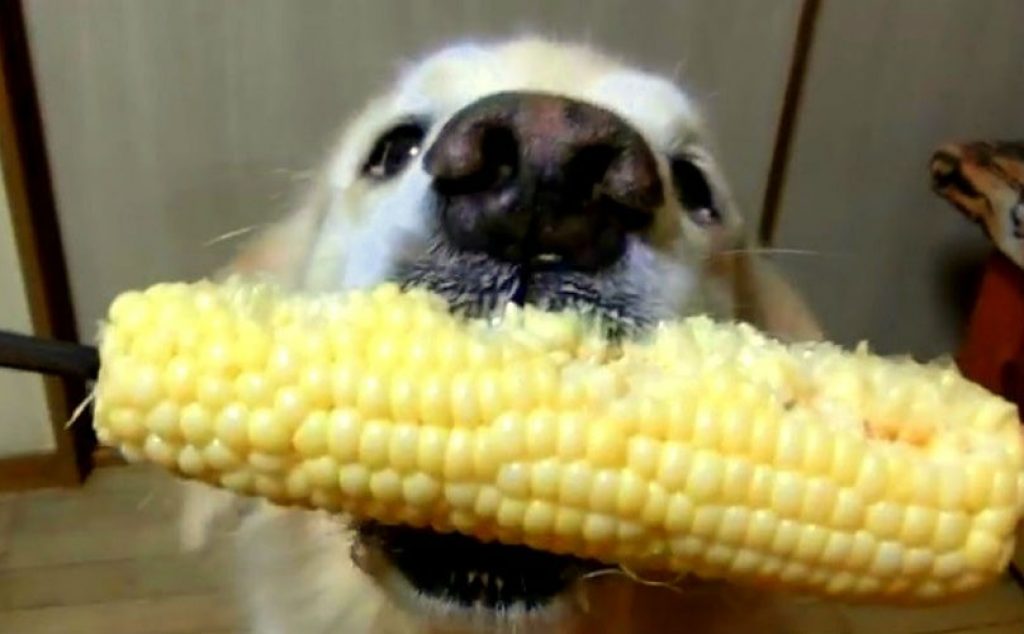
Some of the most well known pet foods are labelled as meat, but most of the ingredients are corn.
Are my dog’s big teeth designed to chew corn on the cob?
This is nothing radical, and it’s a topic which has been widely discussed in pet circles worldwide for years. It revolves around this:
Q. I’m a meat eater, what should I eat?
- Rice Puffs
- Wheat-bix
- Corn flakes
- Meat
Please select only one answer.
Did you pick Meat?
If that’s the case, why are most dog foods made mostly from rice, wheat, and corn?
Dogs have a dental structure and digestive system geared towards eating and digesting meat. Their digestive tract is shorter than ours, which means they can efficiently digest meat and meat proteins, but other types of proteins (i.e. from grains) are harder to digest or even wasted.
Carbohydrates, especially when we’re talking about high carbohydrate foodstuffs, are hard for a dog to digest and even damaging.
So why are most kibbles high in carbohydrates and bulked up with protein sources other than meat?
Carbohydrates aren’t even listed on a pet food packet, and the reason why is they don’t want you to know. Any food with a “typical” rather than a “guaranteed analysis” will likely have much more carbohydrates than you would believe.
Carbohydrates are sugars after all, and we know very well sugars are unhealthy in excess. But that’s not the worst of it, particularly for cats who face a constant battle being fed grains every day, and grains in pet food are often the nastiest of all.
The saving grace for pet food manufacturers is it takes years for an inappropriate diet to grind down your dog’s organs, and by that time they can argue it’s old age or bad luck. No accountability needed.
Dispelling myths #2 – Same sh*t, every day
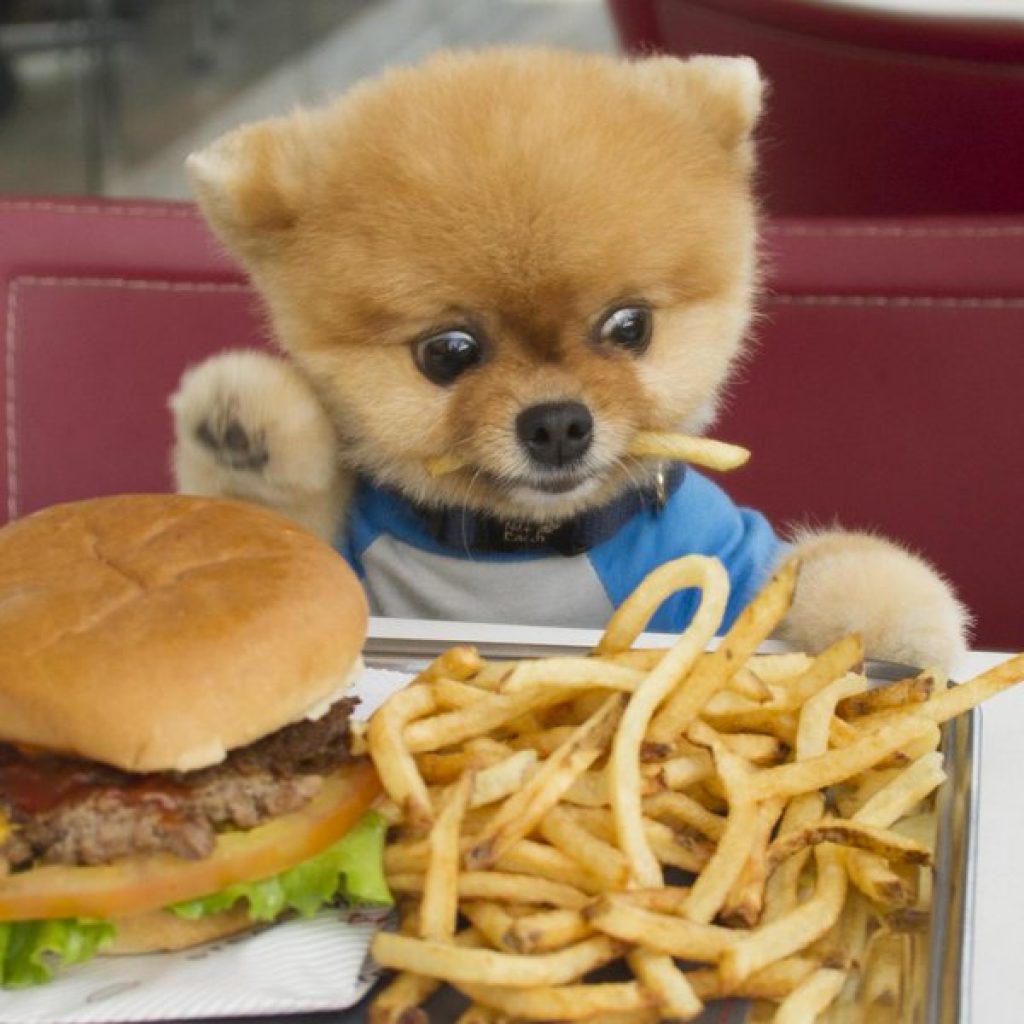
Millions of people pick a brand of pet food when their dog’s a puppy, or continue to feed what the breeder fed them, and that’s what they give their dog for life. Why?
Dogs shouldn’t eat the same food every day…
…and they definitely shouldn’t eat the same sh*t every day.
Let’s talk about McDonalds.
I’m not saying McDonalds food is sh*t. When I’m late for a gig or a jam with the band I’ll pick up a Big Mac on the way. I realise it’s unhealthy, but the odd burger really isn’t going to affect my health or my gut, is it?
Go on, look at it! It looks tasty, doesn’t it?
But what if I swung by Maccas every morning on my way to work, and every evening on my way home? I’d look like Santa by Christmas.
Fortunately I have an active life and love running around the park and playing ball games… (yep, I’m a bit like a dog, aren’t I?)
Despite my diet my lifestyle would keep me trim, and I’d be more reminiscent of Marathon Santa and his hareem of foxy elves.
But I’m sure you’d agree, as would McDonalds CEO Chris Kempczinski, that my insides would be pretty screwed up after months of burgers and fries.
So let me be far flung out and radical for a second….
Why would you feed worse to your dogs every single day?
You may not believe pet food is worse than the infamous MacDonalds beef patty, but consider this:
Even McDonalds can’t legally sell “pet grade” meat in their burgers.
We live in an age where people feed their dogs very poor quality food, and they feed it every single day.
I can’t stress this enough.
Maybe that’s why 3 in 5 dogs (and 1 in 3 cats) end up with cancer?
Dispelling myths #3 – Please don’t change my diet, I’ll be sick

Every now and then, for whatever reason, people decide to start feeding their dog a different food, only to find the new food makes their dog sick. Or does it?
Changing a dog’s diet isn’t the cause of sickness and diarrhoea.
The picture below shows a clause on the back of a supermarket brand of dog food. It reads “Your dog may have a sensitive stomach. A rapid change in diet may cause them to become suddenly ill, which may result in vomiting and / or diarrhoea.”
This is true, but it’s very misleading.
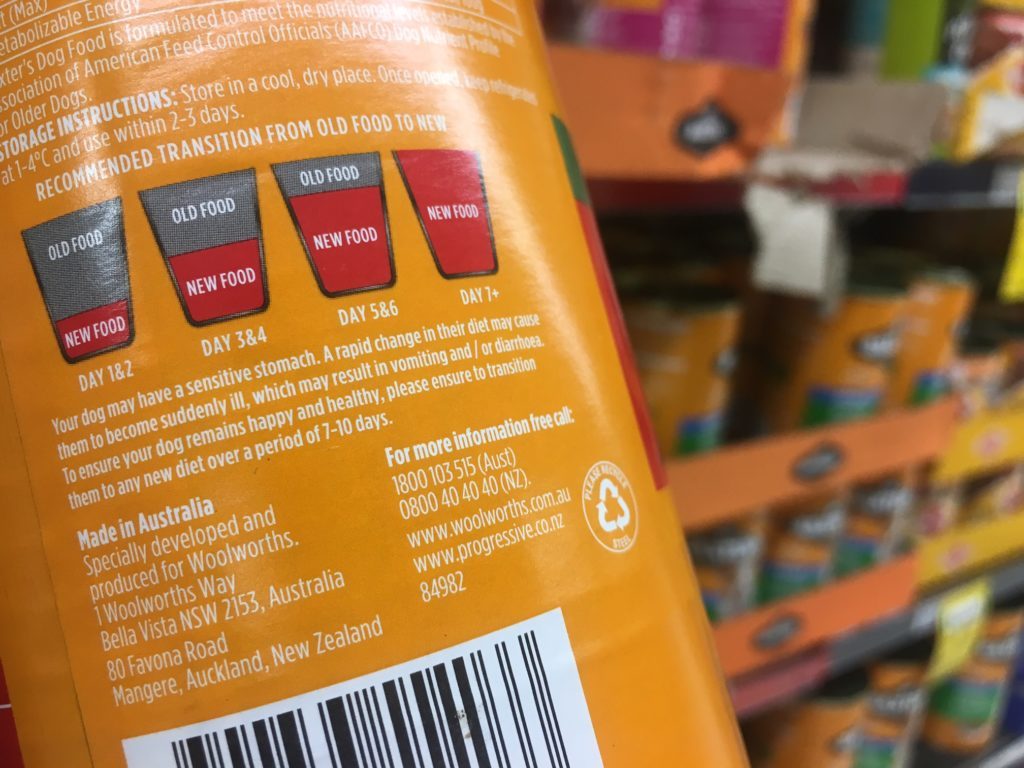
Let’s discuss humans for a second. If you were to eat Wheat-bix morning, noon, and night, and nothing else, for months (or even years). What would happen to your guts if one day you ate some lentils?
Your guts would probably explode!
The room would be full of toxic gas!
Your toilet seat will become your closest companion, and you’ll feel a bit down in the dumps about the pains and groans in your belly.
Our pets, just like us, develop intolerance if (a) we eat the same thing for a long period of time, or (b) we cut something from our diet for a long period of time.
If grandma sucked on some eggs, if she hadn’t had eggs in years, she’d probably have a few bowel movements.
Something I hear all the time is “This new food’s making my dogs sick, I’m taking it back to the store to complain“.
Regardless of whether a new food is good or bad, the sickness and diarrhoea probably isn’t caused by the new food (although don’t rule it out). It could be the old food, or more likely it could be because the dog hasn’t eaten anything different for so long they’ve become intolerant of other foods.
That’s not a good thing, and the worst thing you can do is put him back on the old food and forget about it.
Why do we believe a dog should eat the same food all the time and develop intolerance, when we know it’s really not a good thing for us humans?
I’ll tell you why:
Pet food manufacturers have trained us to believe changing foods is bad. The reason is simple, and it’s nothing to do with nutrition:
They want you to feed their product for the entire lifespan of your dog.
Dispelling myths #4 – I love this food, it’s soooo good

I often hear people say a food is good because their dog “LOVES IT!”.
Why do they love it? Kids love McDonalds. I love beer. Would you say McDonalds and beer are a nutritionally sound diet?
So far I’ve talked about McDonalds a fair bit, so let’s talk about kids and cake for a while.
Kids friggin’ love cake! If you feed your kids cake all the time they would love it!
Dogs are no different and will eat whatever you put in their bowl. Kids and dogs don’t know the importance of nutrition, but we do, and therefore their health is our responsibility.
If you put a Big Mac and fries in your dogs bowl, would they love it?
If you put Sugar Coated Corn Pops* in their bowl they would love that too?
Given Sugar Coated Corn Pops are full of sugar, food colourings and humectants, I’m pretty sure your dog will easily become addicted (sorry, I mean “love it”).
Q. Because a kid loves a food, does it mean it’s nutritious?
Of course it doesn’t. Foods aimed at kids are high in sugar, because that’s what kids love. Lot’s of dog foods use similar techniques, with ingredients designed to make your dog “love” the food. These ingredients are called palatants, or palatability enhancers.
A palatant can be anything from salt to fatty broths skimmed off the top of a vat of boiling maggoty chickens.
Spinach isn’t very palatable, but chuck on some bacon dressing and it’s a different story.
What if you chucked bacon dressing on a bowl full of soy bean hulls? That sounds less appealing, but I’m sure your dog would seemingly love it.
Now we’re more in the ball park of many brands of dog food sold and fed in the millions.
Because your dog eats a food, even enthusiastically, doesn’t mean the food is good, and it definitely doesn’t mean it’s healthy.
* Sugar Coated Corn Pops are a made up cereal. I don’t wish to mar a brand name unnecessarily.
Here’s a picture of what I imagine Sugar Coated Corn Puffs to look like. Food colouring’s have been added to make the food look appealing to us humans. Our dogs don’t care, they can only see in black and white.
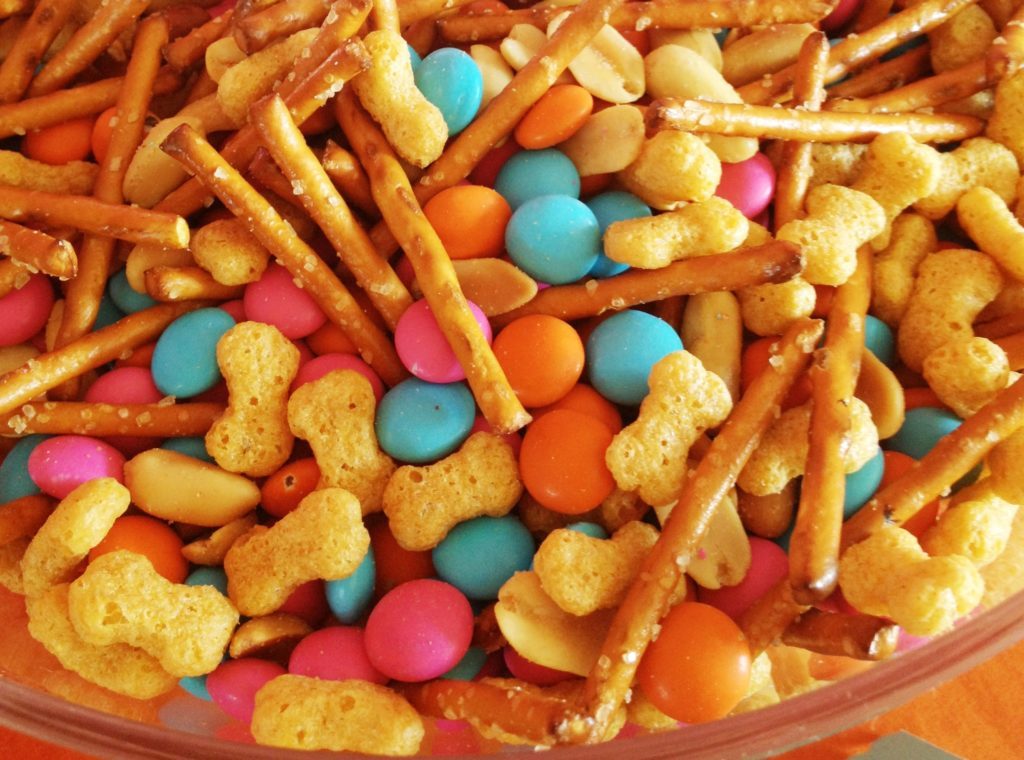
Feeding strategies
There’s a mega-spectrum when it comes to feeding a dog (or cat). It depends on budget, but also lifestyle, situation, and where you live.
Feeding a brand of dry food to a dog every day of their life is a huge misconception which arose from corporate marketing. Manufacturers want you to feed their product all the time. This is about profit not your pet. Variety is as important for our dogs as it is for us.
Keep that word in mind – variety.
If you can feed a carefully considered raw diet that’s awesome, but if dry food on a budget is your only option then don’t feel dismayed – I’ll give you cost-effective tips!
I’m an advocated for varied homemade raw/fresh diets, but as someone who works all the hours under the sun I appreciate the convenience of feeding dry food. I always feel slightly guilty feeding dry food, even ones I know are pretty good, so I mix it up with all the fresh titbits and meats as and when I can.
Remember, you can only do your best, and seeing as you’ve found this website you’re on the right path.
Let’s begin…
Feeding strategy #1 – Help, I’m on a budget
If you’re on a budget and supermarket dry food is your only feasible option, then here’s some quick tips on supplements and fresh foods to greatly improve the health of your dog.
Let me get one thing out of the way – most dry foods are highly processed convenience foods and not as nutritious as the packaging says. They’re high in carbs (aka sugar) and bulked up with fillers. If you feed a dry food then at least take time to read the ingredients and get an understanding of it.
There are great (and cheap) ways to supplement a dry food diet to greatly improve the health of your pet, such as supplements from the pet store or fresh foods from the supermarket.
3 Simple Supplements
Here are three good supplement recommendations which should really boost the health of any dog, no matter what diet they are fed:
- Green lipped mussels or sustainably sourced Krill oil as excellent sources of marine omega 3 fatty acids.
- Digestive enzymes to help break down carbohydrates, fats, and proteins, and absorb nutrients.
- Probiotics as beneficial “good” gut bacteria to help maintain gastrointestinal health.
There’s a guide on probiotics and digestive enzymes here, and a little more information on green lipped mussels. Green lipped mussels can be bought frozen from some supermarkets, and one every day or two can be fed as a treat!
Supermarket Bargains, Fresh Meats, Fresh Foods
Lots of pet products are poor quality with inflated prices. “Pet grade” meat is illegal to sell as human food for the simple reason it’s worse quality. So why not buy “Human grade” meats? It can work out cheaper!
If your local supermarket is like mine you’ll always find meat and meat products reduced for quick sale, so when you’re doing the weekly shop why not look for meaty bargains your dog would love?
All of these are cheap and great for dogs – chicken necks & frames, livers, kidneys, hearts, meaty bones, brisket bones.
Breast meats and prime cuts are also great, especially when they’re yellow stickered at 50% off.
The occasional tin of tuna or sardines (in spring water) is another cheap option, and I often find these much cheaper than the lesser quality equivalents in the pet food aisle.
The meat and fish counter at my local supermarket is currently selling basa fillets at AUD $5.50/kilo. I bought 5 fillets for $4, so a cheap healthy dinner last night for myself, my two dogs, and my cat.
Your local butcher might stock green tripe which is astoundingly nutritious if you can hack the smell.
We often hear “grains are bad” for dogs, but it’s not strictly true. Cheap grains cooked at high temps into a grain heavy kibble are definitely bad, but home cooking your dog rice, barley, oats, along with a mince such as turkey, chicken, beef, or kangaroo is a great idea. Throwing in some veg wouldn’t go amiss either. All of these ingredients are cheap, and it doesn’t take long to cook up a batch for the week.
Supplementing a dry food with any of the above will greatly improve the ongoing health of your dog, and it doesn’t need to be expensive.
To Cook or not to Cook?
Dogs can stomach raw meats, but use caution. Bones should always be fed raw.
Generally I offer my dogs any red meats raw, but other meats such as pork, or fish I’ll cook or boil. I feed chicken necks and frames raw, but generally with chicken breast I’ll boil it and cut it into squares as excellent nutritious treats.
For the more adventurous you could buy an air drier and make chicken or beef jerky treats which keep for ages.
Variety
Dogs are often fed a monotonous diet, a misconception led by corporate marketing. Over the last 20+ years we’ve seen an alarming increase in unhealthy pets, from itchy skin to cancer.
I’ve said it before and I’ll say it again – variety is as important for our pets as it is for us.
Feeding strategy #2 – No time, have money
This strategy covers emerging freeze dried and air dried foods which offer you a formulated raw diet with the convenience of regular dry food.
Pet food ranges in price considerably. Cheap foods are cheap for a reason, usually because they’re made of GMO grains, by-products from grains, with a token meat content from poor quality sources, rendering plants, and 4-D animals (Dead, Dying, Disabled, Diseased). Doesn’t sound good does it, but this accounts for the majority of pet foods on the shelves.
Fortunately a select number of more “ethical” manufacturers sell better quality foods, but they’re few and far between.
Most dry foods are high in carbs, ranging from 40 to 50%, and given all carbs impact blood sugar this isn’t a good thing. It’s been proven high carbohydrate foods are damaging to dogs, but manufacturers don’t want you aware of this – well, duh, their foods are high in carbs (and carbs are cheap).
Recent years have shown the development of some excellent alternatives. They’re pricier, but in some cases you get what you pay for.
Enter Freeze Dried and Air Dried Raw Diets. A much more natural, species appropriate raw diet, with the convenience of dry food. Rawsome!
Freeze Dried
Back in World War 2 (and possibly World War 1), soldiers carried freeze dried foods because they wouldn’t spoil. The reason for this is moisture has been removed – moisture causes food to go off.
Skip to the present day and freeze-dried dog foods are emerging. This technique offers two excellent benefits:
- Nutrition stays intact. No cooking is involved.
- Shelf life is greatly extended, which means the food will keep as long as dry food does (or longer).
This means we can offer our dogs a highly nutritious properly formulated raw diet with the convenience of dry food. All you need to do is soak it in water for a few minutes before feeding. No real knowledge of raw feeding required.
So what’s the catch?
If you look at the cost per kilo it appears much more expensive than dry food. In truth it isn’t as expensive as it would seem as your dog would need to eat less to absorb the nutrition they need, and it’s far less damaging than the high carbohydrate dry foods we discussed earlier.
Have a look at K9 Natural and Frontier Pets (in Australia).
Air Dried
Air dried is similar to freeze dried, but the food is dried in… well, air. Warm air.
The nutritional value is still largely retained, although not quite as well as freeze dried. It’s still very good, and far better than processed dry foods.
The benefit with air dried is you can poor it into the bowl as you would a dry food. You don’t need to reconstitute it with water like you do freeze dried.
Have a look at ZiwiPEAK and Balanced Life (in Australia).
Feeding strategy #3 – Rawsome
Raw feeding is a huge topic and needs research. It’s not about giving your dog a chicken breast every day. This strategy offers guidance, tips, and a starting point for those who wish to feed their dog the way nature intended.
A wise director of a global pet food manufacturer once said to me “The best diet for a dog is a properly formulated raw diet, but the worst diet for a dog is a wrongly formulated raw diet“.
I have to take deep breaths and count to ten when people say stuff like “If you can’t feed a dog properly you shouldn’t have a dog. Chicken necks all the way.”
I hear this surprisingly often, and a sole diet of chicken necks is arguably worse than feeding a cheap dry food.
Feeding raw isn’t about giving your dog raw meat every day, it’s about feeding a variety of meats, organs, bones, and fresh foods. A dog has a variety of nutritional needs so a raw diet must cover the whole nutritional spectrum.
If you want to feed raw, and credit to you if you can, then make sure you research thoroughly. I won’t cover raw feeding in depth here as I don’t believe I could cover all the bases, but thankfully there’s a wealth of information on the web and in books.
Make sure you research well, and keep in mind a simple and always overlooked principle – variety.
Where do I start?
Have a browse of The Raw Feeding Community as an excellent starting point, and have a go at some of the many raw dog food recipes on Google, YouTube, et al.
It may seem daunting, but there’s a huge and rapidly growing community out there. Who knows, you’ll probably learn a fair bit about your own nutritional needs as well!
Considerations
Dogs are geared to digest raw meats, even rank meats, and they’re better equipped to tackle bacteria. It’s still worth being sensible with your meat sources and shelf lives.
It may sound like common sense, but wash your hands after handling raw meats. Another good tip is don’t let your dog lick you after eating raw meats. My dog tries, but I politely inform her I will not be licked with raw chicken tongue.
Raw bones are soft, but can still cause choking. Feed appropriately sized bones dependent on the size of your dog, and make sure you’re with them while the eat.
This is especially necessary if your dog’s a gulper. If you have more than one dog they may attempt to swallow the bones quickly from threat of the competition.
Further reading
The above guide on how to feed a dog (or cat) will hopefully get you started, and my best tip for you as a dog (or cat) owner is always read labels, and always think about what you’re feeding your pet. If something doesn’t sit right, like feeding a cat grains, then it probably isn’t right.
Here is some further reading:
- Is a dog a carnivore or omnivore?
- Why do vets recommend Hill’s Science Diet?
- What treats are good (and safe) to feed?
We also have a list of dog and cat nutrition reading material (you know, the old kind – books).
Oh, and don’t forget our many reviews of dog foods and cat foods in Australia!
Lastly, if you have read this far then I will assume this guide has been useful reading. If it has, please share this page with others, link to it from your website, or print it out and stick it on the notice board at your vets. Thank you!

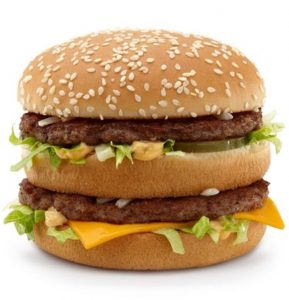




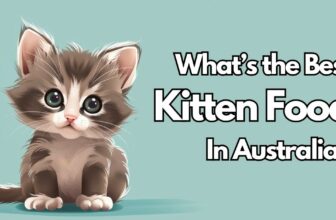

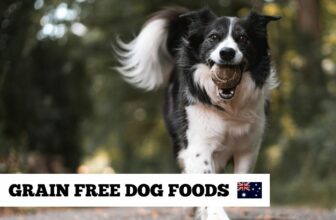
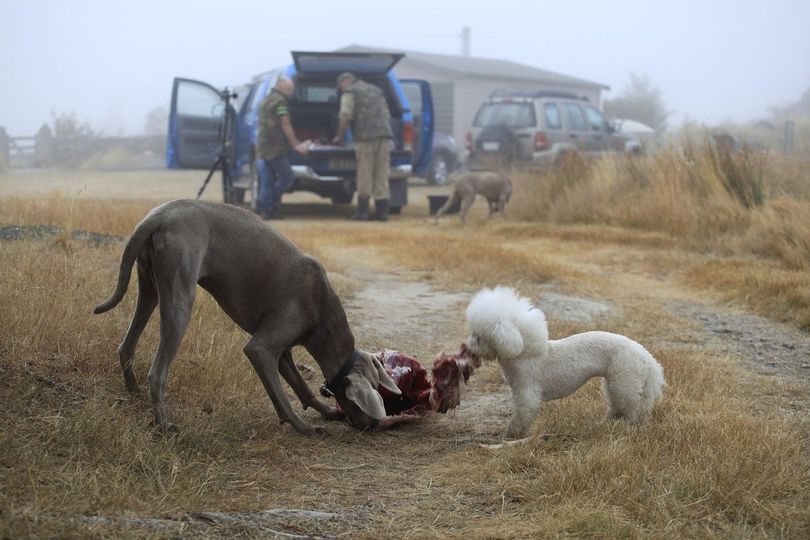
I have two, much loved, Birman cats. They do not seem to eat much and prefer dry food although they have wet food in the morning and evening but only eat part of it. I buy what I thought was the best food like Dine but reviews are terrible. We are not rich, but I would rather go without food so the cats can eat well. One of the cats had to have an operation recently for a blocked intestine and they are very hairy cats, like smaller ragdolls, with hairball problems. I read every word of your excellent article. But would be incredibly grateful if you can please advise me what I should be feeding these important members of the family.
Hi, your information is so helpful. We have a 3 year old Cavalier King Charles and feed him a diet of cooked chicken fillet, 3 or 4 star beef mince (human grade), brown rice, cooked vegetables and a commercial pet food Nature’s Gift with chicken, garden vegetables, brown rice. He also has some dried food and a greenie (teenie) daily fir dental care. We also give him a small amount of dried treats such as Clear Treats brand lamb puffs,dried fish, liver treats as reward on walks. He does get anxious about wanting to get to grass to eat which concerns us but it it is not always to bring on vomiting. Any clues on what he may be missing in his diet would be good to find out. Many thanks, Sue.
Hi Sue, some dogs like the taste of grass. One of my dogs often chews grass, and her diet is the same as my other dog who doesn’t. The diet you’ve said seems pretty good to me, although perhaps some organ meats would be good (often cheap at the supermarkets). You may also find probiotics helps.
Here’s some more info: Probiotics for dogs, Why dogs eat grass, and an article on Foodie Pooch which goes more in depth with the science behind dogs eating grass and dirt (known as Zoopharmacognosy!) – https://www.foodiepooch.com.au/why-do-dogs-eat-grass-and-dirt/
Im a little confused, when you say dogs, does that include cats due to mentioning cats earlier in the article? Im trying to find more information on how to feed my cats best, i have 3 and all have weight issues (since being inside cats and on hills prescription), anxiety issues, 2 long hairs that have hairballs frequently and those two have issues with spewing after eating. Do you have any suggestions for other articles or is this one suitable for them too? Thank you so much for all the effort youve put into this website ! Its so hard finding any information, ive been wanting to do things differently but just struggled to find any information online and vets are no help.
Hi Ebony, yes this is mostly appropriate for cats as well, it’s just when I wrote it I did it specifically for dog owners. With a cat the best thing to keep in mind is they’re an obligate carnivore, and should have a diet consisting of mostly “whole prey” ingredients – meat, organs, bones. If you read the ingredients of the Hill’s Prescription formula you’re currently feeding and ask yourself if it sounds appropriate for a carnivore then that’s a good starting point. There’s a review of Hill’s Prescription Diet which has some info as well.
Thanks for your really informative article. I am a first time dog owner and grateful for any advice. I have just ordered a trial pack of Frontier, but in the meantime I am cooking up some turkey mince with rice and vegetables.
However, unlike prepared food, there is no information on the amount to feed my dog.
How much should I give a 2 year old, 8 kg Labradoodle?
I would really appreciate your advice.
Hi Robyn, feeding guidelines are loose at the best of times, and it depends on so many factors. So the best advice is feed them as much as you think they need, and they’ll probably let you know if they’re hungry. Or if they gain weight you can cut back. I usually find more protein (from animal ingredients) in the diet satiate your dog much more than high carb foods.
Beware of cheap sardines such as the Aldi & WW’s brand. They drain the oil to be used elsewhere (vitamin supplements is one use). Thusly, there are very few omega oils in the sardine meat.
Brunswick & John West (I think) keep most sardines ‘whole’ therefore much more nutritious than the cheaper brands.
Cheers …
R.
That’s really interesting, and explains the difference in cost between brands and home brands of sardines.
Ok. I’m more confused than ever. I have read all the dry food reviews on this site including home cooked and raw. How do I decide? I have 2 whippets. One is only 9 weeks old. I am on a budget so cannot afford the expensive brands. I have been feeding my adult whippet Applaws dry dog food with a small amount of cooked chicken. Is that ok? Can I feed my puppy the same? I started feeding my puppy on cherish puppy and she now has a skin rash. Not sure if it’s from cherish. Can anyone help?
Hi Lizzie, Applaws is a good choice considering the price, and consumer feedback is good compared to other dog foods in that price range. Adding the chicken would certainly help – raw or cooked (just no cooked bones).
Hi,
I am a little confused about how raw diets can lead to deficiencies and health problems if they are not balanced, but you can still feed meat without a complete diet supplement. Is it because it is not just meat you are feeding them? how do you make sure they are not deficient or receiving too much of something?
thanks,
Grace
Hi Grace, it’s a very good question and I’ll do my best to answer…
Have a read of the ingredients for Hill’s Science Diet Adult (I just cherry picked this, but same principle will apply to other brands).
Skip past the barley, wheat, corn, sorghum, corn gluten meal, soybeans, and brewers rice which make up most of the product – all of which you can argue aren’t great for an animal from the Order Carnivora.
All those smaller inclusions such as thiamine mononitrate, calcium pantothenate, riboflavin, biotin, taurine, plus other vitamins and minerals, a dog would normally source from organ meats – because they’re the richest source of those nutrients. Liver, kidney, heart, are prime examples, but also tissue, cartilage, bone, brains.
Dogs have complex nutritional needs which standards such as AAFCO attempt to address – i.e. they set a standard to ensure all required nutrients for a dog are provided in their entirety in that product. This is as they currently know and understand, but it’s worth considering taurine wasn’t a requirement until recently (since the DCM scare in fact – what you read all over the internet about grain free foods causing heart failure). Taurine is now a requirement.
With raw all these nutrients need to be catered for. If any aren’t then the dog can become deficient, which may take a long period of time.
With kibble, especially given most people only feed one product for the life of their dog, it puts complete reliance on that product being complete with all nutrients, in an absorbable form. To me that’s putting a great deal of trust in that product for those complex nutritional needs.
I hope that answers your question, although I’m not sure if your question suggests I’ve recommended simply feeding meat as a balanced diet, which is not how it should read!
I tried Frontier Pet Foods…
Please check out this Australian small business that is attempting to provide the most complete and satisfying dog food for your beloved pet dog. It is overseen by Vets in Perth to ensure that every meal is completely well balanced and nutritionally complete, as well as tasty for your dog. When I learned about this small Perth dog food company, and did lots of research about them, I was truly impressed. Please let me know what you think about their amazing Dog Food.
I have a flat coat retriever who eats to live. She can go for 2 days without eating, an absolute nightmare. I have tried raw meat, mince, beef, lamb. I air fried a whole chicken, given it to her cooked. I’ve given her raw chicken necks I’ve slow cooked silverside. She will eat all of them at least once, won’t try it again. Actually that’s not true. She does eat beef mince occasionally, just not the cheaper mince, only at least 3 star. She’s not a big biscuit eater. I have 2 cats and she does clean up what they don’t eat every so often. We are vegetarians and she doesn’t like what we eat. She does like cheese. We did give her appetite stimulants from the vets, didn’t do much after 2 weeks. She’s 16 kilos, 20 months old and has barely put on any weight in 6 months. Any ideas? She has not eaten anything for 3 days right now and is not interested, we have spent $380 on tests to see if there are any internal problems, nothing. The vets just said, she eats to live.
Frontier Pets is a great dog food. I’ve fed it to my dogs and they’ve done really well on it, and they never leave it in the bowl for more than a few seconds unlike kibble. They’re actually over in Evans Head in NSW – I went to visit them last year and it’s a beautiful place.
Our local poultry shop sells’pet mince’ which is minced Chicken frames. Would it be okay for our dog to be having this daily, along with some kibble, a little extra meat and legumes? My main concern is whether having a high proportion of chicken bones on a daily basis is an issue.
Thanks so much for your web site. It is fantastic!
Hi Katrina, thank you so much for the positive feedback – always appreciated!
Minced chicken frames can certainly be a cost effective way to bulk up a dog (or cat)’s diet, or even just regular chicken frames – the chewing is good for your dog’s teeth. You’re right to be concerned with feeding a high proportion though, as a balanced diet (such as raw) would require a range of nutrients from organ meats as well. Too much bone can be problematic, but only over a long period. But you’re also feeding quality protein as well.
Personally I buy some mince about once a week, which may last a day or two. It’s very cheap per kilo at my local butchers. I don’t feed it every day though.
There’s some great raw feeding groups on Facebook. Most will dictate specific ratios but I don’t tend to overthink it. We don’t eat our meals in fixed ratios!
I have read the reviews on frontier and I am impressed unfortunately it is too expensive for me. I have 2 whippets so they eat about 3 cups per day between them.
For most people on a budget (which really is most people!) it’s worth adding some of these top end foods as part of the diet, even if it’s a bowl every other day or every few days. Adding variety to a dog’s diet I always consider a good thing, as otherwise you’re relying on a single food to be “perfect”.
Very, very informative. Thank you.
I currently feed my 11 month old Beagle on the Hills Science puppy dry food and fresh kangaroo meat.
I also try to cook extra veges to add variety to the diet.
If I get rid of the dry food can I just use more veges and mix up the protein to include chicken and organ meats?
I worry about the nutrient requirements.
I also have a 12 year old Maltese who was fed traditional supermarket dry and tin foods and now has pancreatitis and always has had bad teeth and breath so I’m really searching for a better way to feed my beagle.
Hi Carol, bad teeth (as well as periodontal disease leading to poor overall health) I see as common with pet foods in general – wet or dry – and believe chewing (such as on raw meaty bones) is good in that respect.
Switching to a full raw/fresh diet isn’t as complex as it may sound, but knowing the basics is a must. I find some of the raw feeding groups on Facebook a bit much at times (such as people saying you MUST feed this ratio, that ratio, or ELSE), but they’re still a valuable resource. The first two (easy reading) books on this page are a great start – Work Wonders and Give Your Dog a Bone, both by Australian vets.
Another option which might be a good way to start transitioning to a more “raw” diet is to feed the kibble, kangaroo, and veggies, is one of the off-the-shelf raw (or dried raw) foods. All these are complete and balanced so contain essential vitamins, minerals, oils, plus a range of meat and organs which you won’t find in the kibble.
Thank you